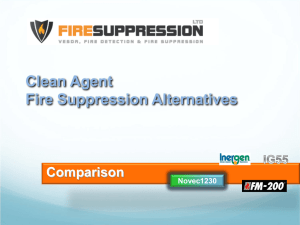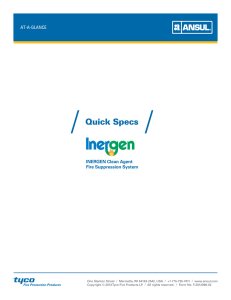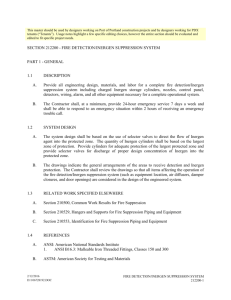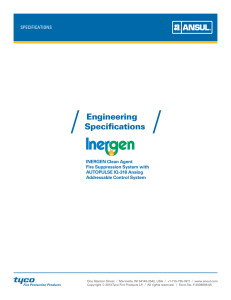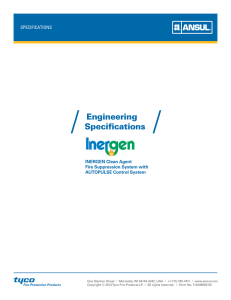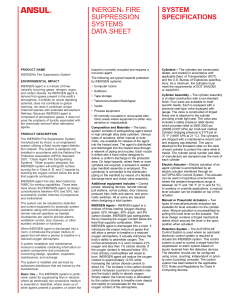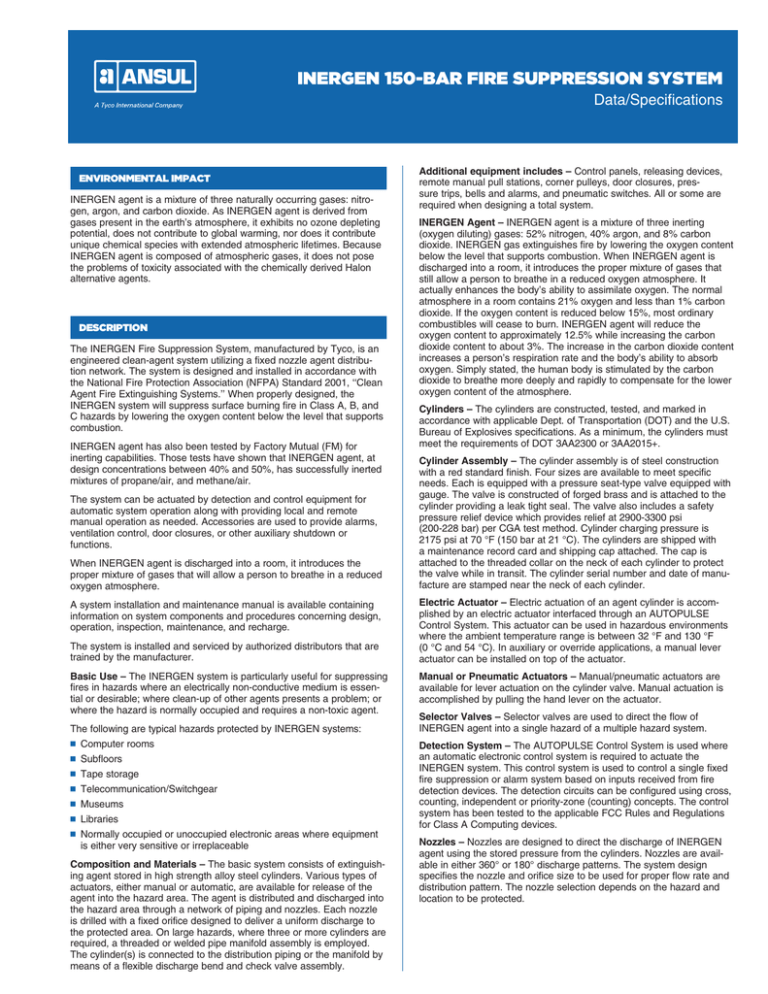
INERGEN 150-BAR FIRE SUPPRESSION SYSTEM
Data/Specifications
ENVIRONMENTAL IMPACT
INERGEN agent is a mixture of three naturally occurring gases: nitrogen, argon, and carbon dioxide. As INERGEN agent is derived from
gases present in the earth’s atmosphere, it exhibits no ozone depleting
potential, does not contribute to global warming, nor does it contribute
unique chemical species with extended atmospheric lifetimes. Because
INERGEN agent is composed of atmospheric gases, it does not pose
the problems of toxicity associated with the chemically derived Halon
alternative agents.
DESCRIPTION
The INERGEN Fire Suppression System, manufactured by Tyco, is an
engineered clean-agent system utilizing a fixed nozzle agent distribution network. The system is designed and installed in accordance with
the National Fire Protection Association (NFPA) Standard 2001, ‘‘Clean
Agent Fire Extinguishing Systems.’’ When properly designed, the
INERGEN system will suppress surface burning fire in Class A, B, and
C hazards by lowering the oxygen content below the level that supports
combustion.
INERGEN agent has also been tested by Factory Mutual (FM) for
inerting capabilities. Those tests have shown that INERGEN agent, at
design concentrations between 40% and 50%, has successfully inerted
mixtures of propane/air, and methane/air.
The system can be actuated by detection and control equipment for
automatic system operation along with providing local and remote
manual operation as needed. Accessories are used to provide alarms,
ventilation control, door closures, or other auxiliary shutdown or
­functions.
When INERGEN agent is discharged into a room, it introduces the
proper mixture of gases that will allow a person to breathe in a reduced
oxygen atmosphere.
A system installation and maintenance manual is available containing
information on system components and procedures concerning design,
operation, inspection, maintenance, and recharge.
The system is installed and serviced by authorized distributors that are
trained by the manufacturer.
Basic Use – The INERGEN system is particularly useful for suppressing
fires in hazards where an electrically non-conductive medium is essential or desirable; where clean-up of other agents presents a problem; or
where the hazard is normally occupied and requires a non-toxic agent.
The following are typical hazards protected by INERGEN systems:
n Computer rooms
n Subfloors
n Tape storage
n Telecommunication/Switchgear
n Museums
n Libraries
n Normally occupied or unoccupied electronic areas where equipment
is either very sensitive or irreplaceable
Composition and Materials – The basic system consists of extinguishing agent stored in high strength alloy steel cylinders. Various types of
actuators, either manual or auto­matic, are available for release of the
agent into the hazard area. The agent is distributed and discharged into
the hazard area through a network of piping and nozzles. Each nozzle
is drilled with a fixed orifice designed to deliver a uniform discharge to
the protected area. On large hazards, where three or more cylinders are
required, a threaded or welded pipe manifold assembly is employed.
The cylinder(s) is connected to the distribution piping or the manifold by
means of a flexible discharge bend and check valve assembly.
Additional equipment includes – Control panels, releasing devices,
remote manual pull stations, corner pulleys, door closures, pressure trips, bells and alarms, and pneumatic switches. All or some are
required when designing a total system.
INERGEN Agent – INERGEN agent is a mixture of three inerting
(oxygen diluting) gases: 52% nitrogen, 40% argon, and 8% carbon
dioxide. INERGEN gas extinguishes fire by lowering the oxygen content
below the level that supports combustion. When INERGEN agent is
discharged into a room, it introduces the proper mixture of gases that
still allow a person to breathe in a reduced oxygen atmosphere. It
actually enhances the body’s ability to assimilate oxygen. The normal
atmosphere in a room contains 21% oxygen and less than 1% carbon
dioxide. If the oxygen content is reduced below 15%, most ordinary
combustibles will cease to burn. INERGEN agent will reduce the
oxygen content to approximately 12.5% while increasing the carbon
dioxide content to about 3%. The increase in the carbon dioxide content
increases a person’s respiration rate and the body’s ability to absorb
oxygen. Simply stated, the human body is stimulated by the carbon
dioxide to breathe more deeply and rapidly to compensate for the lower
oxygen content of the atmosphere.
Cylinders – The cylinders are constructed, tested, and marked in
accordance with applicable Dept. of Transportation (DOT) and the U.S.
Bureau of Explosives specifications. As a minimum, the cylinders must
meet the requirements of DOT 3AA2300 or 3AA2015+.
Cylinder Assembly – The cylinder assembly is of steel construction
with a red standard finish. Four sizes are available to meet specific
needs. Each is equipped with a pressure seat-type valve equipped with
gauge. The valve is constructed of forged brass and is attached to the
cylinder pro­viding a leak tight seal. The valve also includes a safety
pressure relief device which provides relief at 2900-3300 psi
(200-228 bar) per CGA test method. Cylinder charging pressure is
2175 psi at 70 °F (150 bar at 21 °C). The cylinders are shipped with
a maintenance record card and shipping cap attached. The cap is
attached to the threaded collar on the neck of each cylinder to protect
the valve while in transit. The cylinder serial number and date of manufacture are stamped near the neck of each cylinder.
Electric Actuator – Electric actuation of an agent cylinder is accomplished by an electric actuator interfaced through an AUTOPULSE
Control System. This actuator can be used in hazardous environments
where the ambient temperature range is between 32 °F and 130 °F
(0 °C and 54 °C). In auxiliary or override applications, a manual lever
actuator can be installed on top of the actuator.
Manual or Pneumatic Actuators – Manual/pneumatic actuators are
available for lever actuation on the cylinder valve. Manual actuation is
accomplished by pulling the hand lever on the actuator.
Selector Valves – Selector valves are used to direct the flow of
INERGEN agent into a single hazard of a multiple hazard system.
Detection System – The AUTOPULSE Control System is used where
an automatic electronic control system is required to actuate the
INERGEN system. This control system is used to control a single fixed
fire suppression or alarm system based on inputs received from fire
detection devices. The detection circuits can be configured using cross,
counting, independent or priority-zone (counting) concepts. The control
system has been tested to the applicable FCC Rules and Regulations
for Class A Computing devices.
Nozzles – Nozzles are designed to direct the discharge of INERGEN
agent using the stored pressure from the cylinders. Nozzles are available in either 360° or 180° discharge patterns. The system design
specifies the nozzle and orifice size to be used for proper flow rate and
distribution pattern. The nozzle selection depends on the hazard and
location to be protected.
Pressure Reducer – The pressure reducer is required in the distribution
piping to restrict the flow of INERGEN agent, thus reducing the agent
pressure down stream of the reducer. The pressure reducer contains
a stainless steel orifice plate which is drilled to the specific size hole
required based on the hydraulic calculation. The orifice plate provides
readily visible orifice identification. The pressure reducer is available in
nine sizes: 1/2 in., 3/4 in., 1 in., 1 1/4 in., 1 1/2 in., 2 in., 2 1/2 in., 3 in.,
and 4 in. NPT.
AVAILABILITY AND COST
Availability – INERGEN Systems are sold and serviced through a
network of independent distributors located in most states and many
foreign countries.
Cost – Cost varies with type of system specified, size, and design.
MAINTENANCE
PRODUCT DESCRIPTION
Pipe and Fittings – The system manifold must be constructed of
Schedule 80 or 160 piping and 2000 or 3000 psi iron fittings, threaded
or welded. The distribution piping down stream from the orifice union
must be constructed of a minimum of Schedule 40 piping with class 300
malleable iron threaded fittings or welded steel fittings. All piping must
be black iron of the following type and grade: ASTM A-53 seamless or
electric resistance welded, grade A or B, or ASTM A‑106 grade A, B,
or C. Do not use ASTM A-120, ASTM A-53 type F or ordinary cast iron
pipe or fittings.
Maintenance is a vital step in the performance of a fire suppression
system. As such, it must be performed by an authorized ANSUL distributor in accordance with NFPA 2001 and the manufacturer’s design,
installation, recharge, and maintenance manual. When replacing components on the ANSUL system, use only ANSUL approved parts.
Limitations – The INERGEN system must be designed and installed
within the guidelines of the manufacturer’s design, installation, operation,
inspection, recharge, and maintenance manual. The ambient temper­
ature limitations are 32 °F to 130 °F (0 °C to 54 °C). All AUTOPULSE
Control Systems are designed for indoor applications and for temperature ranges between 32 °F and 120 °F (0 °C and 49 °C).
TECHNICAL DATA
Applicable Standards: The INERGEN system complies with NFPA
Standard 2001, Standard for Clean Agent Fire Extinguishing Systems,
and EPA Program SNAP, Significant New Alternate Policy.
The INERGEN System is listed by Underwriters Laboratories, Inc. (UL)
and Underwriters Laboratories of Canada (ULC), and is approved by
Factory Mutual (FM).
INERGEN Agent is listed by Underwriters Laboratories, Inc. (UL) and
Underwriters Laboratories of Canada (ULC), and is approved by Factory
Mutual (FM).
INSTALLATIONS
All system components and accessories must be installed by personnel
trained by the manufacturer. All installations must be performed according to the guidelines stated in the manufacturer’s design, installation,
operation, inspection, recharge, and maintenance manual.
One Stanton Street
Marinette, WI 54143-2542
+1-715-735-7411
www.ansul.com
Copyright © 2011 Tyco Fire Protection Products
All rights reserved
Form No. F-9312-11

